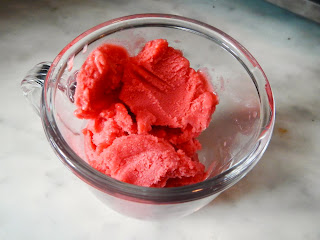Cook's Science
There's a new online publication from Cook's Illustrated called Cook's Science, and they did a special article on ice cream. It's worth reading if you're interested in ice cream. They included some recipes adapted for home equipment and they looked pretty good, so I gave their vanilla a try.
This was a pretty easy one to make (no eggs so no tempering) and didn't require anything not available from a supermarket. I did add 0.5% commercial ice cream stabilizer (Cremodan) to my mix.
The verdict? Excellent! One of the best homemade ice creams I've ever had. The texture is dry and slightly chewy like a good store-bought pint. Not icy at all, not greasy. And because it has no eggs it just tastes of cream and vanilla.
It does freeze pretty hard and needs a little rest out of the freezer before scooping. That's almost impossible to avoid without using multiple sugars (e.g. dextrose), so I assume they were trying to keep it simple. If I make this again I might use a mix of sucrose and dextrose.
If you make the recipe, I recommend you get the best, freshest powdered milk available. The kind that comes in foil packets stays fresh. The kind that comes in a big box tastes stale very quickly.
Salt & Straw
I also came across some recipes from Salt & Straw, the famous Portland, OR ice cream store, published in Lucky Peach. They included a base recipe so I tried that and made a vanilla to compare.
If anything this was an even simpler recipe. It uses evaporated milk to get a thick consistency rather than milk powder. It also uses no eggs.
Unfortunately, while this one had great flavor, it turned out quite icy. Even the mix seemed thinner and more watery, so I'm not surprised. It needed something to tie up some of the water in the milk. It also has a quick meltdown, despite my using the same amount of ice cream stabilizer, and a bit of a greasy mouthfeel from the evaporated milk. So, I won't bother making this one again.
I haven't had a chance to try Salt & Straw at their store, but I'm sure this is not the recipe they use. This is just a home ice cream recipe created by them.









